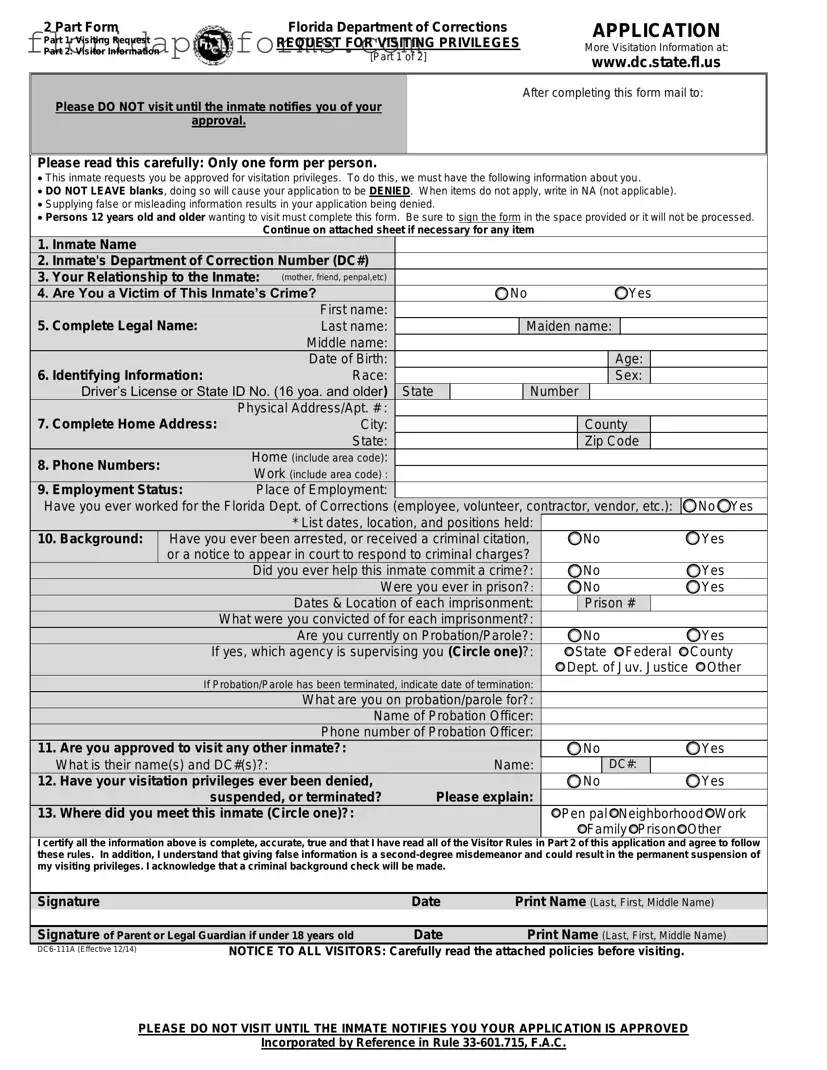The Visitor Application form for the Florida Department of Corrections shares similarities with the Visitor Application form used by the Federal Bureau of Prisons. Both documents require personal information about the visitor, including their relationship to the inmate and background information. Each form emphasizes the need for accurate and complete information, warning that any misleading details could result in denial of visitation privileges. They both also include sections to disclose any criminal history, ensuring that the safety and security of the facility are maintained.
Another comparable document is the Inmate Visitation Application from California's Department of Corrections and Rehabilitation. Like the Florida form, this application collects essential visitor information, including identification details and the visitor's relationship to the inmate. Both forms stress the importance of completing all sections to avoid delays or denials. Additionally, they outline the consequences of providing false information, which can lead to permanent restrictions on visitation rights.
The Texas Department of Criminal Justice has a similar Inmate Visitation Request form. This document, like Florida's, requires visitors to disclose their personal information and any relevant criminal history. Both forms are designed to ensure that only eligible individuals can visit inmates, thus maintaining the safety of the prison environment. They also provide clear instructions on how to submit the application and the importance of waiting for approval before visiting.
The New York State Department of Corrections and Community Supervision also utilizes a Visitation Application form that resembles Florida’s. It asks for detailed visitor information and includes questions about prior criminal history and the visitor's relationship to the inmate. Both forms aim to vet visitors thoroughly to prevent any potential security risks. They also highlight the necessity of signing the application to ensure processing.
The Illinois Department of Corrections has its own Visitor Application form, which shares key features with the Florida form. This document gathers personal details about the visitor and their connection to the inmate. Both forms require complete and truthful responses, with warnings about the repercussions of providing false information. Each form also includes a section for the visitor to acknowledge understanding of the rules governing visitation.
In Michigan, the Visitor Application for Prisoner Visitation is another similar document. It collects extensive information about the visitor, including their criminal history and relationship to the inmate. Both forms serve the same purpose of ensuring that visitation is safe and secure. They also emphasize that incomplete applications may be denied, reinforcing the importance of thoroughness in the submission process.
Finally, the Ohio Department of Rehabilitation and Correction has a Visitation Application that parallels the Florida form. This application also requests detailed personal information and a disclosure of any criminal background. Both documents are designed to ensure that the visitation process is secure and that only appropriate individuals are allowed to visit inmates. They include clear instructions and consequences for providing inaccurate information, ensuring compliance with the rules set forth by the respective departments.


